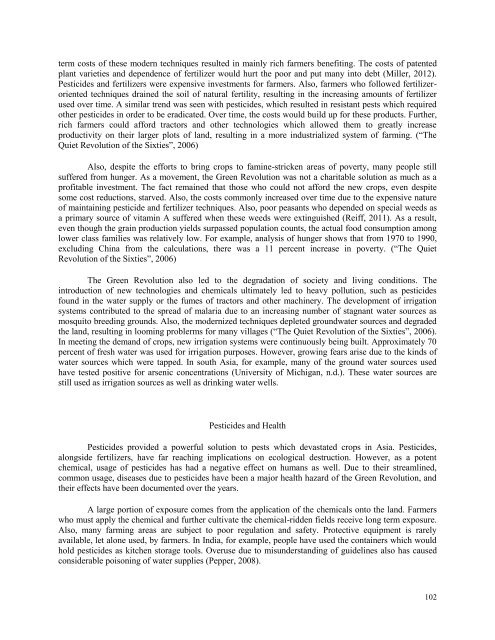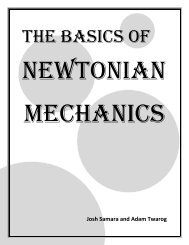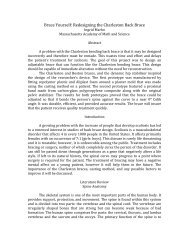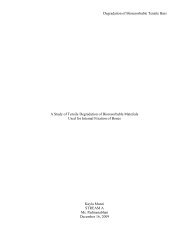Got Food? - the Scientia Review
Got Food? - the Scientia Review
Got Food? - the Scientia Review
Create successful ePaper yourself
Turn your PDF publications into a flip-book with our unique Google optimized e-Paper software.
term costs of <strong>the</strong>se modern techniques resulted in mainly rich farmers benefiting. The costs of patented<br />
plant varieties and dependence of fertilizer would hurt <strong>the</strong> poor and put many into debt (Miller, 2012).<br />
Pesticides and fertilizers were expensive investments for farmers. Also, farmers who followed fertilizeroriented<br />
techniques drained <strong>the</strong> soil of natural fertility, resulting in <strong>the</strong> increasing amounts of fertilizer<br />
used over time. A similar trend was seen with pesticides, which resulted in resistant pests which required<br />
o<strong>the</strong>r pesticides in order to be eradicated. Over time, <strong>the</strong> costs would build up for <strong>the</strong>se products. Fur<strong>the</strong>r,<br />
rich farmers could afford tractors and o<strong>the</strong>r technologies which allowed <strong>the</strong>m to greatly increase<br />
productivity on <strong>the</strong>ir larger plots of land, resulting in a more industrialized system of farming. (“The<br />
Quiet Revolution of <strong>the</strong> Sixties”, 2006)<br />
Also, despite <strong>the</strong> efforts to bring crops to famine-stricken areas of poverty, many people still<br />
suffered from hunger. As a movement, <strong>the</strong> Green Revolution was not a charitable solution as much as a<br />
profitable investment. The fact remained that those who could not afford <strong>the</strong> new crops, even despite<br />
some cost reductions, starved. Also, <strong>the</strong> costs commonly increased over time due to <strong>the</strong> expensive nature<br />
of maintaining pesticide and fertilizer techniques. Also, poor peasants who depended on special weeds as<br />
a primary source of vitamin A suffered when <strong>the</strong>se weeds were extinguished (Reiff, 2011). As a result,<br />
even though <strong>the</strong> grain production yields surpassed population counts, <strong>the</strong> actual food consumption among<br />
lower class families was relatively low. For example, analysis of hunger shows that from 1970 to 1990,<br />
excluding China from <strong>the</strong> calculations, <strong>the</strong>re was a 11 percent increase in poverty. (“The Quiet<br />
Revolution of <strong>the</strong> Sixties”, 2006)<br />
The Green Revolution also led to <strong>the</strong> degradation of society and living conditions. The<br />
introduction of new technologies and chemicals ultimately led to heavy pollution, such as pesticides<br />
found in <strong>the</strong> water supply or <strong>the</strong> fumes of tractors and o<strong>the</strong>r machinery. The development of irrigation<br />
systems contributed to <strong>the</strong> spread of malaria due to an increasing number of stagnant water sources as<br />
mosquito breeding grounds. Also, <strong>the</strong> modernized techniques depleted groundwater sources and degraded<br />
<strong>the</strong> land, resulting in looming problerms for many villages (“The Quiet Revolution of <strong>the</strong> Sixties”, 2006).<br />
In meeting <strong>the</strong> demand of crops, new irrigation systems were continuously being built. Approximately 70<br />
percent of fresh water was used for irrigation purposes. However, growing fears arise due to <strong>the</strong> kinds of<br />
water sources which were tapped. In south Asia, for example, many of <strong>the</strong> ground water sources used<br />
have tested positive for arsenic concentrations (University of Michigan, n.d.). These water sources are<br />
still used as irrigation sources as well as drinking water wells.<br />
Pesticides and Health<br />
Pesticides provided a powerful solution to pests which devastated crops in Asia. Pesticides,<br />
alongside fertilizers, have far reaching implications on ecological destruction. However, as a potent<br />
chemical, usage of pesticides has had a negative effect on humans as well. Due to <strong>the</strong>ir streamlined,<br />
common usage, diseases due to pesticides have been a major health hazard of <strong>the</strong> Green Revolution, and<br />
<strong>the</strong>ir effects have been documented over <strong>the</strong> years.<br />
A large portion of exposure comes from <strong>the</strong> application of <strong>the</strong> chemicals onto <strong>the</strong> land. Farmers<br />
who must apply <strong>the</strong> chemical and fur<strong>the</strong>r cultivate <strong>the</strong> chemical-ridden fields receive long term exposure.<br />
Also, many farming areas are subject to poor regulation and safety. Protective equipment is rarely<br />
available, let alone used, by farmers. In India, for example, people have used <strong>the</strong> containers which would<br />
hold pesticides as kitchen storage tools. Overuse due to misunderstanding of guidelines also has caused<br />
considerable poisoning of water supplies (Pepper, 2008).<br />
102
















